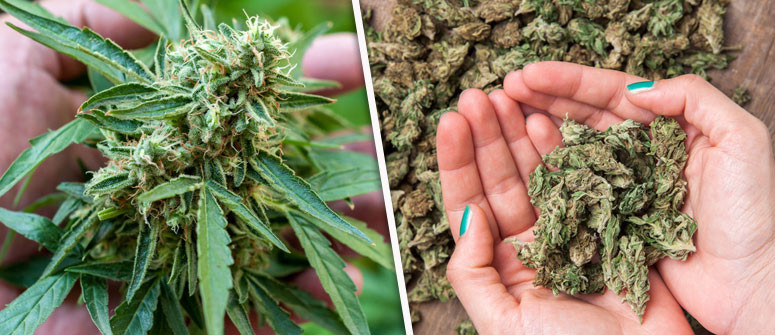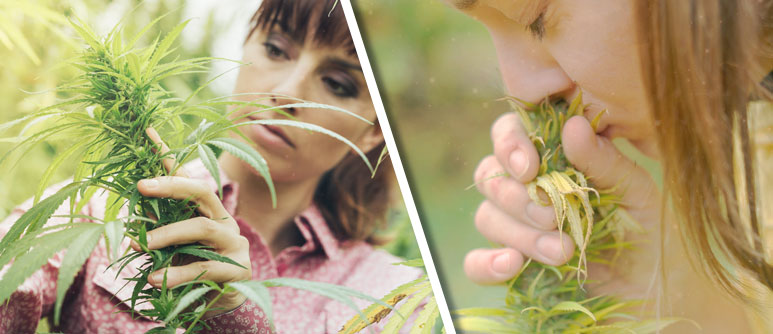How many grams of weed can you get from an individual plant?

Wondering how much weed you'd be able to grow from a single cannabis plant? Find out what to expect when growing your own.
There’s no question that the goal of cultivating cannabis is to obtain the biggest yield possible. Whether you’re growing THC-rich buds to procure a stash that will get you stoned for months to come, or plants that produce flowers loaded with CBD to keep yourself grounded and chilled, the end goal is the same. But how does a cultivator go about ensuring a max yield? And furthermore, how much weed is one plant even capable of producing?
GENETICS ARE FUNDAMENTAL TO HOW MUCH WEED A CANNABIS PLANT CAN PRODUCE
The genetics you start with will play a huge role in how much flower you get at the end of the growing process. Of course, everybody would love to grow tree-like sativa varieties that pump out kilograms per plant, but one needs to remain realistic. Before selecting genetics, take a look at the space and resources you have at your expense, and go from there.
AUTOFLOWERING OR PHOTOPERIODIC?
One of the primary divisions when it comes to growing cannabis revolves around choosing an autoflowering or photoperiodic variety. Photoperiodic strains typically grow much taller, but they require a shift in light cycle to begin flowering. This is a natural process that occurs outdoors, but indoor growers need to add it to their ongoing list of maintenance-related tasks.
Autoflowering strains, on the other hand, reach flowering much faster and don’t require a change in light cycle. This is because they contain Cannabis ruderalis genetics, a subspecies that adapted to northern climates and the different light cycles in these regions. Typically, photoperiodic strains offer significantly greater yields, whereas autoflowering strains often sacrifice yield and size for speed—though this trait is valued by many growers.
INDICA OR SATIVA: CHOOSING AN IDEAL PHOTOPERIODIC STRAIN
Photoperiodic strains can be divided into several categories that harbor different traits due to the environmental demands of their regions of origin. Sativa strains are king when it comes to massive outdoor harvests, while indica strains grow in a bushy fashion and rarely exceed 2m in height. Sativas are naturally tall and lanky, and some strains have no issues reaching towering heights of 3m and putting out yields of well over a kilogram per plant. Indicas, on the other hand, usually put out closer to around 500g/plant. That being said, some indicas have been bred to produce giant, rock-hard buds in superb quantities, making them just as productive in some cases outdoors, and arguably more productive indoors.
SHOULD YOU GROW INDOORS OR OUTDOORS FOR AN OPTIMAL YIELD?
This is another factor that comes down to the grower's personal situation. If a grower happens to find themselves without garden access, or they live in an area of strict prohibition, cropping massive plants outdoors simply isn’t an option. But it’s still possible to obtain large yields indoors considering all other factors are dialed in. That being said, most of the time indoor harvests pale in comparison to the overall yield produced outdoors.
Outdoor plants cultivated directly in the ground have the luxury of spreading their root systems as far as they see fit. This solid anchor allows the above-ground portions of the plant to grow much taller and sturdier. A more massive and advanced root system also enables plants to intake more oxygen, nutrients, and water—all factors that allow them to grow to much more impressive heights, resulting in many more potential bud sites.
SOIL AND NUTRIENTS PLAY IMPORTANT ROLES
Cannabis plants have specific nutritional demands that must be met in order to push their yields to the limit. There are three nutrients in particular, known as macronutrients, that cannabis plants require above all else. These are nitrogen, phosphorous, and potassium. During the vegetative phase, when plants haven’t yet started to produce flowers, they require slightly higher levels of nitrogen and potassium. In contrast, plants in bloom require higher levels of phosphorus and lower levels of nitrogen to produce optimal yields. Plants also require other nutrients in smaller amounts throughout the grow cycle, known as micronutrients, including magnesium, calcium, zinc, iron, sulfur, and more.
If you want huge yields, you’ll need to provide your plants with the right amount of nutrients without overfeeding them. Nutrient solutions can be added to potted plants at several stages to make sure all of their needs are met. The easiest way to go about this is to purchase premixed formulas that have been specially designed for this very purpose.
When growing directly in the ground, an ideal way to provide a large spectrum of nutrients is to use compost. Compost should contain a ratio of around 2:1 of green material—which feeds soil microorganisms and provides a nitrogen source—to brown, woody material, which provides sufficient carbon. These materials will be broken down and eventually become a fine, dark humus that contains many of the nutrients required by cannabis plants.
If you’re looking to obtain maximum yields from an autoflowering strain, you’ll have to take a different approach to soil. Autoflowering strains don’t require anywhere near as much nutrients during the grow cycle, and instead prefer light and aerated soils. This mix can be achieved by adding perlite and coco coir.
LIGHTING IS KEY
Lighting is perhaps the most important factor when it comes to a successful cannabis grow. Plants use light to photosynthesize, which allows them to create their own supply of energy to fuel their growth. Outdoor growers have the luxury of growing directly in the sun, making lighting considerably less complicated. For indoor growers, lighting is one of many factors that needs to be tended to in order to create an ideal synthetic environment.
There are many types of lights that growers can choose from. LEDs are some of the most popular and require very little energy to run; plus, they generate next to no heat. However, the initial purchase of these lights is usually more of an investment than the alternatives. Other popular light types include CFLs and HID lights.
Regardless of the type of light you use, it’s the wattage that’s chiefly important. A standard estimate is that 1 watt will produce 1 gram of flowers. This is believed to be within the upper range of what a single plant can produce. This means if you were to use a 600W light source, you could end up with a max yield of 600g/plant, and so on. Of course, there are many more variables at play here, and generally indoor yield is measured in g/m². But overall, the more powerful your light source, the better your yield.
Investing in a lux meter is an affordable way to make sure you’re not going wrong with lighting. These devices allow you to make sure you’re supplying your plants with enough light, and will help you to detect optimal spots for growing.
THE MORE YOU GROW, THE MORE YOU’LL KNOW

Just like any other skill, you’ll get better at growing cannabis—and producing max yields to suit—the more you practice. When growing for the first few times, it’s an achievement in itself to merely reach harvest time. But after a while, you’ll develop a taste for much bigger yields.
As your experience and skill increase, you’ll become much more efficient at feeding and watering your plants, and at getting to know the exact time that these events should take place. You’ll also become considerably more green-fingered and comfortable with manipulating and shaping your plant to force them to produce more flowers.
There are many tried and tested techniques that have been proven to boost flower quantity and size, including methods such as ScrOG, SOG, main-lining, topping and fimming, low-stress training (LST), and defoliation. The main goal of these techniques is to shape your plants in a way that allows for greater light penetration, resulting in better yields.




